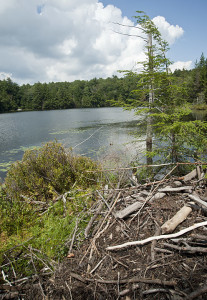How Did Dolphin Pond Get Its Name?
A Look into Norfolk’s Past
By Ryan Bachman
In December 1803 Norfolk resident Peter Freedom received a crushing verdict from the Litchfield County Court. Because of debts incurred by his recently deceased father, Dolphin, the son was ordered to sell the family farm in southwestern Norfolk. The 40-acre property had only been in the Freedom family for six years, but in that time they had managed to carve out a modest farm from the rock-strewn landscape. In the centuries after the farm was sold, the memory of its past occupants has lived on in the name of a small pond located on the old Freedom property.
While most of Norfolk’s ponds are named after well-known families from the town’s past, such as the Benedicts, Crisseys and Bigelows, Dolphin Pond is unique in that it is named after a former slave. Dolphin Pond’s name stands as a tangible reminder of the history of slavery and emancipation in Norfolk. The years that Dolphin Freedom spent in Norfolk spanned the era in which the State of Connecticut gradually abolished the institution of slavery, and by the time of his death in 1801 he had experienced life in the community as both the literal property of others and as a property owner himself.
Unfortunately, much of Dolphin’s early history is unknown. In Theron Crissey’s “History of Norfolk,” he is described as an “Indian,” so he may have had both African and Native American ancestry. By 1763 Dolphin was owned by the Camp family, and he moved to Norfolk from Durham, Conn., with the Camps after they purchased a large farm on Mountain Road. Dolphin’s initial stay in Norfolk was brief. Before the Camps moved to the Northwest Corner, Dolphin had begun a relationship with an enslaved woman in Durham named Zillah. Only a year after moving to Norfolk, Dolphin and Zillah were married, and Abraham Camp sold his slave to a prominent Durham family so that Dolphin could remain near his new wife. For the next two decades, Dolphin and Zillah, as well as their son, Peter, who was born in 1774, lived in Durham with their respective owners’ families. Dolphin would not return to Norfolk until after he and his family had been granted their freedom.
Following the American Revolution, popular opinion in Connecticut began to turn against slavery. In 1784 the state legislature passed a policy of gradual emancipation, which legally required slaveholders to free only those enslaved people born after March 1 of that year. For individuals like Dolphin, Zillah and Peter, this meant that their freedom depended on the goodwill of their owners. In fact, Dolphin and his family were emancipated in 1788, and they chose an appropriate surname, “Freedom,” to celebrate their new status.
Rather than remain in Durham, Dolphin Freedom elected to bring his family back to the community where he had once briefly resided with the Camp family. Evidently, Norfolk had made a positive impression on him as a young man. For eight years, the Freedoms rented houses on various farms where Dolphin worked as a laborer, until he saved up enough money to buy property of his own along the shore of the pond that would one day bear his name. Father and son each constructed houses on the farm, and Dolphin and Zillah Freedom joined Norfolk’s Congregational Church, the center of the community’s social, as well as spiritual, life.
Unfortunately, by the start of the 19th century, Dolphin found himself deeply in debt to several Norfolk businessmen. He died in 1801 before his financial issues could be resolved. Zillah had died several months earlier, and the two were laid to rest side by side in Norfolk’s Center Cemetery under two small, simply inscribed stones. For two years, Peter Freedom struggled to keep possession of the family farm, until it was finally sold under the direction of the county court. Because of the property’s relatively remote location and poor soil quality, the Freedom homestead was never inhabited again, and within several decades the forest began to reclaim the landscape.
Today, few traces of the farm remain, and Dolphin and Zillah’s gravestones are nearly illegible. Only a glance at a topographical map of Norfolk reveals the pond that stands as a reminder of Dolphin Freedom and his family.
Photos by Bruce Frisch.



I got to read this via my cousin’s wife who is a Melville ( in Norfolk) by marriage. I am a Melville whose grandmother on my mother’s side was a Bigelow. The Bigelow’s lived at The Knoll in Norfolk at the turn of the 20th century. This was an incredible piece to read on someone so unknown and yet whose name still exists on topographical maps. I just wanted to thank the author for his sleuthing and work he did in retrieving such a story and bring it to us here in the present day.